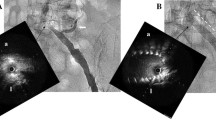Abstract
Background/Purpose
May-Thurner syndrome is an uncommon disease entity in which the left common iliac vein is compressed by the right common iliac artery with subsequent development of deep vein thrombosis and chronic venous insufficiency. We report our experience on the treatment of extensive iliofemoral deep venous thrombosis due to May-Thurner syndrome using endovascular techniques.
Methods
The study group comprised 21 patients (8 men, 13 women; mean age 51 years) diagnosed with May-Thurner syndrome by venogram. Eighteen patients were treated with catheter-guided thrombolysis; 3 patients with short segment involvement did not require thrombolysis. After completion of the thrombolytic therapy, the residual venous narrowing was treated by balloon angioplasty and/or placement of a self-expandable stent.
Results
The mean total dose of urokinase was 4.28 ± 1.89 million units, and the mean duration of infusion was 72 ± 35 hr. Eighteen of the 21 patients received stent deployment. The mean diameter of the stents was 12.9 ± 2.0 mm. Initial technical successes with immediate symptom resolution were achieved in 20 of the 21 patients (95%). We performed a follow-up venogram 6 months after procedure and checked clinical symptoms at outpatient clinics (mean follow-up duration 10.8 months). Among the patients who received stent implantation, 2 had recurrent thrombotic occlusion during the follow-up period. Three patients, who did not receive stent implantation, all had recurrent thrombosis. There were no major bleeding complications except in 1 patient who developed retroperitoneal hematoma.
Conclusion
Catheter-guided thrombolysis and angioplasty with stent implantation is a safe and effective method for the treatment of May-Thurner syndrome.


Similar content being viewed by others
References
May R, Thurner J (1956) Ein Gefassporn in der Vena iliaca communis sinistra als wahrscheinliche Ursache der uberwiegende linksseitigen Beckenvenenthrombose. Z Kreisl-Forsch 45:912–922
Baron HC, Sharms J, Wayne M (2000) Iliac vein compression syndrome: A new method of treatment. Am Surg 66:653–655
Burroughs KE (1999) New considerations in the diagnosis and therapy of deep vein thrombosis. South Med J 92:517–520
Binkert CA, Schoch C, Stuckmann G, Largiader J, Wigger P, Schoepke W, Zollikofer CL (1998) Treatment of pelvic venous spur (May-Thurner syndrome) with self-expanding metallic endoprostheses. Cardiovasc Intervent Radiol 21:22–26
Gerald JO, Charles PS, Craig B, Stephen TK, Manmood KR, Daniel YS, Michael DD (2000) Endovascular management of iliac vein compression (May-Thurner) syndrome. J Vasc Interv Radiol 11:823–836
Heijmen RH, Bollen TL, Duyndam DAC, Overtoom TTC, Berg JCV, Moll FL (2001) Endovascular venous stenting in May-Thurner syndrome. J Cardiovasc Surg 42:83–87
Steinberg JB, Jacocks MA (1993) May-Thurner syndrome: A previously unreported variant. Ann Vasc Surg 7:577–581
Eklof B, Kistner RL (1996) Is there a role for thrombectomy in iliofemoral venous thrombolysis? Semin Vasc Surg 9:34–45
O’Donnell TF, Browse NL, Burnand KG, Thomas ML (1987) The socioeconomic effects of iliofemoral thrombosis. J Surg Res 22:483–488
Strandness ED, Manzo RA, Markel A (1993) Is there a role for thrombolytic treatment of deep vein thrombosis? Cardiol Board Rev 10:25–27
Sherry S (1985) Thrombolytic therapy for DVT. Semin Interv Radiol 2:331–337
Semba CP, Dake MD (1994) Iliofemoral deep venous thrombosis: Aggressive therapy with catheter-directed thrombolysis. Radiology 191:487–494
Mewsissen MW, Seabrook GR, Meissner MH, Cynamon J, Labropoulos N, Haughton SH (1999) Catheter-directed thrombolysis for lower extremity deep venous thrombosis: Report of a National Multicenter Registry. Radiology 211:39–49
Vedantham S, Vesely TM, Sicard GA, Brown D, Rubin B, Sanchez LA, Parti N. Picus D (2004) Pharmacomechanical thrombolysis and early stent placement for iliofemoral deep vein thrombosis. J Vasc Interv Radiol 15:565–574
Nazarian GK, Bjarnason H, Dietz CA, Bernadas CA, Hunter DW (1996) Iliofemoral venous stenosis: Effectiveness of treatment with metallic endovascular stents. Radiology 200:193–199
Whittemore AD, Donaldson MC, Polak JF, Mannick JA (1991) Limitations of balloon angioplasty for vein graft stenosis. J Vasc Surg 14:340–345
Patel NH, Stookey KR, Ketcham DB, Cragg AH (2000) Endovascular management of acute extensive iliofemoral deep venous thrombosis caused by May-Thurner syndrome. J Vasc Interv Radiol 11:1297–1302
Author information
Authors and Affiliations
Corresponding author
Rights and permissions
About this article
Cite this article
Kim, JY., Choi, D., Guk Ko, Y. et al. Percutaneous Treatment of Deep Vein Thrombosis in May-Thurner Syndrome. Cardiovasc Intervent Radiol 29, 571–575 (2006). https://doi.org/10.1007/s00270-004-0165-7
Published:
Issue Date:
DOI: https://doi.org/10.1007/s00270-004-0165-7




